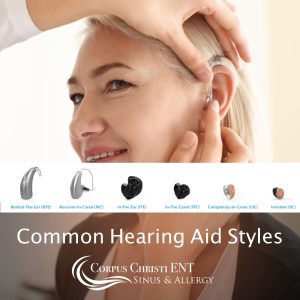
There are so many different brands of hearing aids, it sometimes becomes confusing. However, no matter what brand of hearing aid it is, the style or shape of the hearing aids is fairly consistent from one to the other. Let’s look at the most common styles of hearing aids.
There are two primary categories hearing aids fall into. The first is custom or in-the-ear (ITE) and the second is standard or (BTE). Each category can be further subdivided into smaller categories.
Custom hearing aids or in-the-ear (ITE) hearing aids
Custom hearing aids are aids that are completely contained within the ear. They are molded to fit your ear. In order to be fit with a custom aid the Audiologist takes an impression of your ear using a silicone putty. The impression is then sent to the manufacturer along with a copy of your hearing test results in order to make a hearing aid specific to your ear and loss. Custom aids come in a variety of sizes. The largest is the full shell, and then get progressively smaller, to a half shell, in-the-canal, mini-canal, completely-in-canal, and in some cases the invisible-in-canal (not available from all manufacturers). In the past, and to a certain degree even today, the more severe your hearing loss, the larger the hearing aid needed to be. Due to the size of the aids, the smaller aids do not necessarily have all of the features available in the larger aids such as directional microphones, wireless capabilities, or volume controls.
- The full shell ITE fills the bowl portion of the ear completely. It is usually fit on someone who has extremely severe hearing loss, or someone who has poor vision or limited use of their hands or fingers. Since it is larger, it is easier to handle. It takes a larger battery, which is also easier to handle and does not have to be changed as often (approximately every 7-10 days).
- The half shell aid is a little smaller. It fills the ear canal and the lower portion of the bowl of the ear, but does not typically move up into the upper folds of the ear (the helix area). The battery for this aid is a little smaller and lasts approximately 5-7 days.
- The In-the-Canal or ITC aid is a bit smaller, with even more of the aid fitting into the ear canal and less into the back portion of the bowl of the ear. It typically uses the same size battery as the half shell aid.
- Even smaller, the Mini-canal fits with only a small portion of the aid showing in the bowl portion of the ear with the majority of the aid in the ear canal. This hearing aid uses the smallest of the hearing aid batteries and will need to be changed every 3-4 days.
- Finally, the CIC, the Completely-In-Canal aid sits within the ear canal so that only the face of the hearing aid is visible at the opening of the ear. It also uses the smallest battery.
Standard hearing aids or behind-the-ear (BTE) hearing aids
Standard hearing aids have either all, or majority of the electronics of the hearing aid located behind the ear. There are three version of this aid available, a traditional BTE, a slim-tube BTE and Receiver-in-Canal (RIC). Each one also is available in different sizes which vary with the amount of gain provided.
- A traditional BTE has all the electronics located behind the ear and them a plastic earpiece is attached to deliver the sound the ear. Most of the time, the earpiece is molded to your ear. This aid is available in different size (usually dependent on how much volume is necessary) so usually available in up to 3 or 4 different battery sizes.
- The traditional BTE can also be fitted with what is called a slim tube. Instead of a custom fitted ear mold with a tube, a thinner tube with a more universal earpiece is used. Typically used with milder hearing losses, it will take the medium sized battery that lasts about 5-7 days.
- A smaller version is the Receiver-In-Canal or RIC hearing aid. In this case the receiver, the part of the hearing aid that converts the electrical signal back into sound, sits in the ear. The aid portion that sits behind the ear is smaller and there is a thin wire that connects the receiver to the aid. This aid can fit all severities of hearing loss and is available in three different battery sizes as well as with a rechargeable battery.
Make your appointment today to see an Audiologist and find out what style of hearing aid will work best for you.